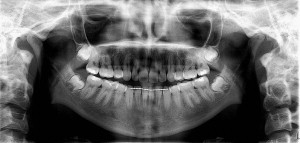Given the prevalence of third molars, high incidence of associated pathology, and cost of care (surgical or active surveillance), decision-making and management strategies for third molars have received a great deal of attention. Understandably, there are controversies that surround wisdom teeth, including the optimal time for treatment, if and when to prescribe medications such as antibiotics, steroids, and analgesics, the actual costs (financial and otherwise) of treatment and retention, and what constitutes monitoring of retained teeth. The “gorilla in the room,” however, involves what are appropriate indications for the removal of third molars, particularly those that are asymptomatic. The debate has intensified as proponents of retaining asymptomatic third molars have focused their concerns on cost containment ( Fig. 1 ).

It is not surprising that not all parties of interest (patients, families, surgeons, and third-party payers) see things in the same way.
-
Typical desires/perspectives:
-
Patients and families
- •
Best treatment at most convenient time
- •
Minimal risk
- •
Least eventful recovery
- •
Minimal expense
- •
Minimal red tape
- •
-
Providers
- •
Freedom to recommend and provide the best treatment
- •
Fair compensation
- •
Minimal red tape
- •
-
Third parties
- •
Manage costs
- •
Keep purchasers and insured satisfied
- •
-
Terminology
- •
“Asymptomatic” does not indicate the absence of disease—merely a lack of symptoms.
- ○
There is a significant difference between disease-free and asymptomatic.
- ○
Because pathology always precedes symptoms and because dental disease often progresses without symptoms, it is prudent for decision making to include the presence (or likely development) of pathology as opposed to being asymptomatic.
- ○
-
Terminology
- •
“Asymptomatic” does not indicate the absence of disease—merely a lack of symptoms.
- ○
There is a significant difference between disease-free and asymptomatic.
- ○
Because pathology always precedes symptoms and because dental disease often progresses without symptoms, it is prudent for decision making to include the presence (or likely development) of pathology as opposed to being asymptomatic.
- ○
-
Misconception
- •
Many simplify decision making to consist of either removal or retention.
- ○
The management of wisdom teeth is a complex topic with options including removal, partial removal (coronectomy), or retention with subsequent clinical and radiographic surveillance. Surgical exposure, repositioning, transplantation, surgical periodontics, and marsupialization of associated soft-tissue pathology with observation and possible secondary treatment are also possible choices for surgical management.
- ○
-
Misunderstanding
- •
Some critics suggest that oral and maxillofacial surgeons should not be involved in the decision-making policy for third molars on the grounds that it represents a conflict of interest.
- ○
The dental profession in the United States is made up of about 80% general dentists, and most of the remaining 20% are not surgeons. Therefore, most patients who seek third molar consultation have been referred from a different dental professional who has nothing at stake other than the well-being of their patients.
- ○
Leaving policy making to those lacking the experience and expertise of an oral and maxillofacial surgeon replaces their input with that of someone less qualified.
- ○
Stay updated, free dental videos. Join our Telegram channel

VIDEdental - Online dental courses


